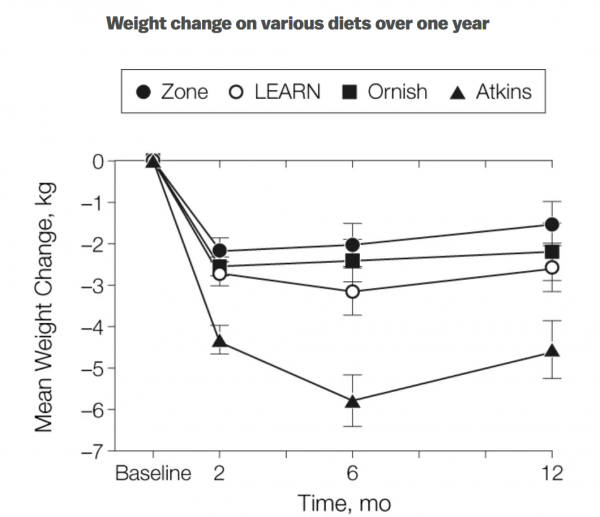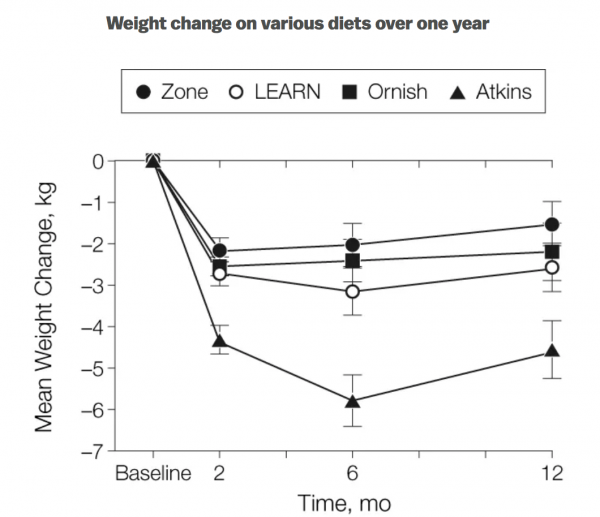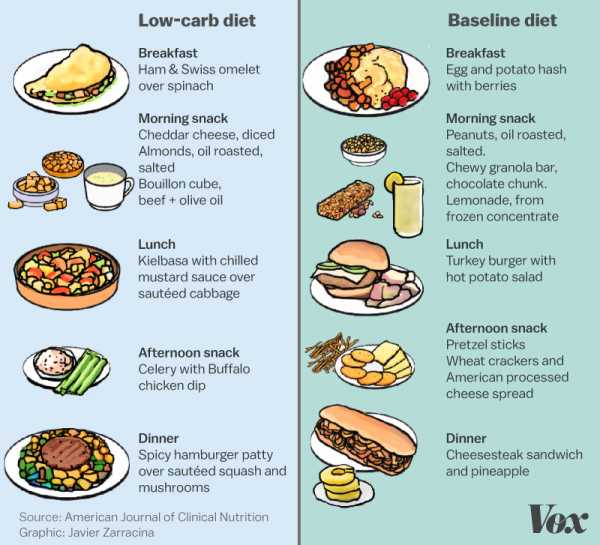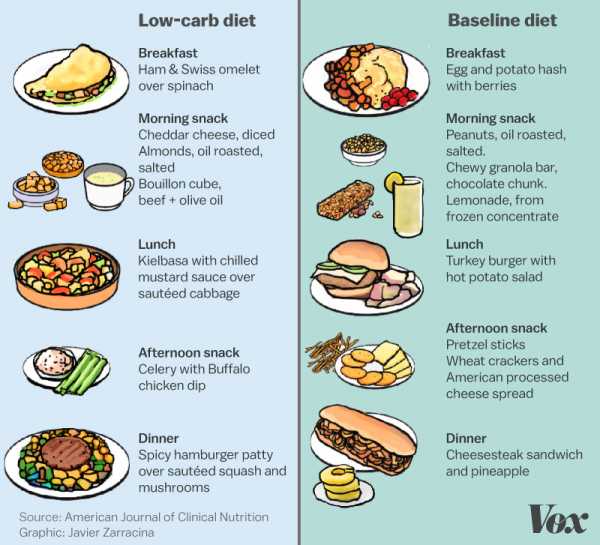
It’s why people are putting grass-fed butter in their coffee, downing ketone drinks, and replacing their cereal and pasta with eggs and avocados.
The ketogenic diet has become a Silicon Valley obsession and the diet du jour that supposedly keeps celebrities like Kim Kardashian and Halle Barry trim and strong.
Keto devotees believe that if you banish most carbs (including fruit!) and embrace fat, you can lose weight without feeling hungry.
The diet’s long history in science also lends it credibility. Doctors have been prescribing ketogenic diets to treat epilepsy for nearly a century, and increasingly believe it may hold promise for people with Type 2 diabetes.
But what’s lost in the many trend articles and books about “going keto” for weight loss today is that this diet is the same one the now-late Dr. Robert Atkins and other low-carb evangelists have been selling since the 1960’s. (Diet peddlers have an incredible knack for rebranding old ideas — over and over — and in our eternal confusion about what to eat, we keep falling for it all.)
Those older keto diets didn’t work for most people hoping to slim down, and there’s no evidence the newly popular keto diet will be any different. Here’s why.
How the ketogenic diet works
To understand the ketogenic diet, you need a quick primer on how the the human body gets energy. We are fueled primarily by glucose, or blood sugar, much of which we derive from carbohydrates in foods like bread, fruit, potatoes, and sweets.
If glucose levels in the blood drop to really low levels, we’d pass out and die. But, interestingly, the body can’t store much glucose — only enough to last a couple of days. So if we forgo eating carbs for a few days, we need other ways to keep going. One of those is a process called ketogenesis.
In ketogenesis, our livers start to break down fat into a usable energy source called ketone bodies, or ketones for short. “Organs like the brain that normally rely primarily on glucose for fuel can begin to use a substantial amount of ketones,” said Kevin Hall, a National Institutes of Health senior investigator who has studied the ketogenic diet extensively. So ketones can stand in for glucose as fuel for the body when there’s a glucose shortage. “It’s an amazing physiological adaption to starvation that allows tissues like the brain to survive,” Hall added.
Once ketogenesis kicks in and ketone levels are elevated, the body is in a state called “ketosis.” There are a few ways to get into ketosis. One is through fasting: When you stop eating altogether for an extended period of time, the body will ramp up fat burning for fuel and decrease its use of glucose (which is part of the reason people can survive for as long as 73 days without food).



Another way to get into ketosis is by eating less than 20 to 50 grams of carbs — or a slice or two of bread — per day. So people on ketogenic diets get 5 percent of their calories from carbohydrates, about 15 percent from protein, and 80 percent from fat. Note that that’s a much lower ratio of protein and more fat than you’d get on other low-carb diets, but it’s this ratio that will force the body to derive much of its energy from ketones.
In practice, that means subsisting mainly on meats, eggs, cheese, fish, nuts, butter, oils, and vegetables — and carefully avoiding sugar, bread and other grains, beans, and even fruit. Again, if this sounds familiar, it’s because it’s not that different from the Atkins diet, among the most famous very low-carb diets that promise to get your body burning fat. (Atkins promised to help people “stay thin forever,” the same way the now popular Keto Reset Diet book promises to “burn fat forever.”)
While the evidence behind ketogenic diets for diabetes is still preliminary and the evidence for weight loss isn’t all that convincing (more on that next), the evidence of using the diet to treat epilepsy is extremely robust. The idea of treating people with epilepsy with the keto diet came about in the 1920s, when researchers observed that people who fasted experienced fewer seizures. (Researchers still aren’t sure why the diet can work for epilepsy, but a few mechanisms have been proposed, including making neurons more resilient during seizures.)
Today, studies have shown that children and adults whose epilepsy doesn’t respond to medications seem to experience a pretty large reduction in seizures when following a ketogenic diet. That doesn’t, however, mean that the diet works for other conditions.
The theory behind very low-carb diets is that they help people burn extra calories and fat — and lose more weight
Advocates of ketogenic diets for weight loss claim that ketogenesis can lead to a “metabolic advantage” that helps burn 10 times more fat and an extra 400 to 600 calories per day — the same as a vigorous session of physical activity. The main scientific model that’s used to explain that advantage is the ”carbohydrate-insulin hypothesis,” which has been promoted by experts like Harvard professor David Ludwig, Obesity Code author Jason Fung, journalist Gary Taubes, and pediatric endocrinologist Robert Lustig, among others.
Eating carbs drives up insulin production, the hypothesis suggests, stirring hunger and causing the body to hold on to fat and suppress calorie burn. But when you replace carbs with fat, you subdue hunger, boost calorie burn, and melt away fat. With fewer carbs, your body also doesn’t produce as much insulin — and that increases the rate of ketogenesis and decreases the body’s need for glucose.
This might sound great, but what’s often lost in all the boosterism is that this is still just a hypothesis. And most studies of ketogenic and other very low-carb diets suggest they don’t actually outperform other kinds of diets in the long run when it comes to weight loss.
Keto diets don’t seem to help people lose extra weight in the long run
The keto concept has been catnip for many dieters, perhaps because of the failure of the low-fat experiment of the 1980s and ’90s to help people lose weight, and the fact that food companies increasingly tell us to be suspicious of carbs and eat more protein.
When you look at head-to-head studies comparing low-carb diets to other kinds of diets, weight loss on a very low-carb diet can be a little more dramatic in the short term, but by the one-year mark, all diets perform equally miserably.
This seminal randomized trial, published in JAMA in 2007, involved 300 women and measured their weight loss on the Atkins diet compared to the Zone, Learn, and Ornish diets. The researchers found that while women on Atkins shed a few more pounds, the weight loss was “likely to be at least as large as for any other dietary pattern.” In other words, Atkins wasn’t substantially better than the other diets.



Other big studies comparing popular diets of different macronutrient compositions, like the one I mentioned above, consistently suggest that the very low-carb approach isn’t a sustainable solution for weight loss. A review of the research on weight loss for different types of diets, published in the Lancet in 2015, found that people on low-carb diets lost 1 kilogram of additional weight after one year compared to people on low-fat diets — again, a marginal difference.
Still, in the short term, low-carb diets like keto can sometimes help people lose more weight because they cause rapid water loss, which gives people the impression they’ve lost fat. “This happens because low-carbohydrate diets deplete stored glycogen, and glycogen binds large amounts of water,” explained obesity researcher Stephan Guyenet.
Another reason very low-carb diets seem to help with weight loss initially is that there’s some evidence they’re effective for appetite control, “so most people actually eat fewer calories than they would on most other diets,” said Guyenet, adding: “The evidence supporting this isn’t great right now, but that seems to be where it’s going.”
But again, these benefits seem to disappear in the long run, probably because very low-carb diets — like many other fad diets — are hard to stick to. In our food environment, it’s extremely difficult to avoid eating foods like bread, cookies, or pasta for months on end. As Guyenet wrote on his blog:
Even people who adhere to a very low-carb diet in the short term don’t necessarily reap the benefits proponents claim they will — like the increased calorie burn and fat loss. That’s what the NIH’s Kevin Hall found in another study he designed that’s considered the most rigorous scientific test of ketogenic diets for weight loss.
For the study, he confined 17 overweight and obese patients for two months to a hospital, where researchers measured their every movement and controlled what they were eating. (Diet researchers called this study the “gold standard” since it was an extremely well-controlled experiment, with all food provided, and it used the best technologies for measuring energy expenditure and body composition.)
In the first month of the study, participants were put on a baseline diet, which was designed to be similar to what they reported they were eating outside the hospital, including lots of sugary carbohydrates. For the second month, the participants got the same amount of calories and protein as they did in the first month of the study, but ramped up the amount of fat in their food and ate far fewer carbs.



The benefits for the participants following the very low-carb diets weren’t nearly as dramatic as ketogenic proponents claim. While the participants saw their insulin levels drop and stay low, they only saw a small increase in calorie burn, and that waned over time. (That short-lived increase in calorie burn amounted to about 100 extra calories per day — much less than the 400 to 600 calories promised by low-carb gurus.)
Compared to the baseline diet, the low-carb diet did not cause subjects to experience an increase in fat loss. To be more specific, it took the full 28 days on the low-carb diet for the subjects to lose the same amount of fat as they did in the last 15 days on the baseline (higher-carb) diet that wasn’t even designed to get them to lose weight. So the researchers did not find evidence of big benefits regarding energy expenditure or fat loss after switching to a low-carb diet.
”According to the insulin-carbohydrate model, we should have seen an acceleration in the rate of body fat loss when insulin secretion was cut by 50 percent,” Hall told me when the study came out. But he didn’t, which he thinks suggests that the regulation of fat tissue storage in the body has to do with more than just insulin levels and their relationship with the carbs we eat.
The results of the study were also echoed by a previous paper on the insulin-carbohydrate model, where Hall found that when people cut fat in their diets, they had slightly greater body fat loss than when they cut the same number of calories from carbs.
When I recently asked Hall what this research tells us about weight loss with the ketogenic diet, he said simply: “The idea is that low-carb, ketogenic diets cause your body to burn way more calories, resulting in a lot of weight loss, even if you eat more than you were eating before. But our studies, as well as many others, demonstrate nothing of the sort.”
For diabetes specifically, keto may be helpful — but the “reversal” claim is overblown
Now that we’ve gotten the weight loss claims out of the way, let’s look at a more promising area of research: using the ketogenic diet as a way to treat or manage Type 2 diabetes.
With Type 2 diabetes, the body lacks sufficient insulin to move glucose from the blood into the cells for energy. Eating carbs results in an increase in blood glucose — so if you vastly cut down your carbs, your blood glucose levels won’t go up as much, and you won’t need as much insulin to manage blood sugars. It’s not surprising that researchers have been finding that people who follow a ketogenic diet can better manage their blood sugar by cutting down their carbs.
In one of the most recent studies on the question, which appeared this month in the journal Diabetes Therapy, 262 adults with Type 2 diabetes patients followed a ketogenic diet, coupled with intensive lifestyle counseling. After a year, among the 218 people who completed the study, their hemoglobin A1C (a measure of blood sugar) dropped on average to 6.3, just below the 6.5 percent threshold for Type 2 diabetes. The need for insulin was either reduced or eliminated in 94 percent of the participants who were using insulin when the study began. Their use of diabetes medications — other than metformin — also declined, from 57 percent to 30 percent, and metformin use decreased slightly, from 71 percent to 65 percent.
These are impressive results. And other randomized controlled trials on the effects of low-carb diets for Type 2 diabetes have also found improved glycemic control and reduced medication use among patients.
But the new study was sponsored and run by employees of Virta Health, a company selling lifestyle counseling on ketogenic diets for Type 2 diabetics. Virta, as well as other proponents of keto for diabetes, claims the diet can “reverse” diabetes — and that’s going to a step too far.
“What’s been demonstrated is that [the ketogenic diet] controls blood glucose levels,” explained Guyenet. “That’s a good thing. But to show true remission or reversal, you have to show a person can go back to being able to eat carbs without having diabetes again.” And that has never been proven with the ketogenic diet.
Indeed, many studies have shown the opposite effect — that the body’s ability to tolerate carbohydrates can decrease after following a low-carb, high-fat diet.
Another common effect of the ketogenic diet is “keto flu”: fatigue, lightheadedness, and dizziness people feel when they greatly reduce their carb intake. This effect should go away after the body adjusts to the diet, but staying on keto for a long time may lead to kidney stones, high cholesterol, constipation, slowed growth (in young people), and bone fractures.
Still, if you have diabetes, it might be worth talking about the ketogenic diet with your doctor. But if you’re going keto to lose weight, buyer beware: In the long run, it looks a lot like other fad diets.
Sourse: breakingnews.ie
0.00 (0%) 0 votes


































